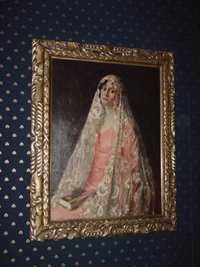Elizabeth Bibesco
|
|
Elizabeth (Asquith) Bibesco (February 26, 1897 - April 7, 1945) was an English writer, active between 1921 - 1940. A final posthumous collection of her stories, poems and aphorisms was published under the title "Haven" in 1951, with a preface by Elizabeth Bowen.
Elizabeth was the first child of Herbert Henry Asquith (British Prime Minister, 1908-1916) and his second wife, Margot (Tennant). It is said that Elizabeth and her brother Anthony would throw things from the third floor windows of 10 Downing Street at the suffragettes shackled to the railings below. Life as the Prime Minister's daughter thrust her into the public eye at an early age and she developed a quick wit and a social presence beyond her years. When she was just 14 years old, The Times (reporting on her recovery from pneumonia) stated that "many members of the House have made the acquaintance of Miss Asquith and in expressing their concern for her health, have referred to her charm of manner and to the interest which she has begun already to show in political matters."
As a teenager, during World War I, she was given opportunities to do "good works", organizing and performing in "matinees" for the servicemen. Her first known literary effort was a short duologue called "Off and On" which she performed with Nelson Keys in 1916 at the Palace Theatre. In the same year she organized a large show of portraits by John Singer Sargent at the Grafton Galleries to aid the Art Fund and a "Poets' Reading" in aid of the Star and Garter Fund.
In 1919 she married Prince Antoine Bibesco, a Romanian diplomat stationed in London, a man twenty-two years her senior. It was the society wedding of the year, attended by everyone from the Queen to George Bernard Shaw. After their marriage, they resided in Paris at the Bibesco townhouse on the Quai Bourbon at the tip of the Ile St Louis looking up the river toward Notre Dame cathedral. The walls of the apartment were decorated with huge canvases by Vuillard. "They weren't pictures. They were gardens into which you walked through a frame," wrote Enid Bagnold.
Prince Bibesco was a life-long friend of Marcel Proust and after his marriage to Elizabeth she too became a favorite of the reclusive writer. At the time of her marriage Proust wrote that she "was probably unsurpassed in intelligence by any of her contemporaries," and added that "she looked like a lovely figure in an Italian fresco". He would leave his house late at night to visit them, to discuss Shakespeare with Elizabeth or to gossip with Antoine until dawn. Elizabeth wrote a moving obituary for Proust in the November 1922 New Statesman. "Gently, deliberately, he drew me into that magic circle of his personality with the ultimate sureness of a look that needs no touch to seal it. Insensibly you were drawn into that intricate cobweb of iridescent steel, his mind, which, interlacing with yours, spread patterns of light and shade over your most intimate thoughts."
Between 1921 and 1940 Elizabeth wrote three collections of short stories, four novels, two plays and a book of poetry. All of these works have a "continental" sensibility. They deal almost entirely with a kind of love in which the heroines ponder the least gesture of a man until it takes on the proportions of an emotional event with lasting implications, while the heroes spend their time in mute surrender at the feet of remote and disdainful women. "One young poet had described her soul as a fluttering, desperate bird, beating its wings on the bars of her marvellous loveliness," is a sample of her prose style (from the short story "Pilgrimage", 1921).
Her novels and stories, which by 1940 were considered merely fashionable, flimsy stuff with no lasting significance, can now be seen as the illumination of a class of people who were made irrelevant by the First World War but who refused to accept their irrelevance.
Elizabeth Bibesco was connected (especially in the mind of the media) with Virginia Woolf and Katherine Mansfield, neither of whom treated her well in their letters and diaries, especially after a liason between Elizabeth and Mansfield's husband, John Middleton Murry. Woolf wrote, "She is pasty and podgy, with the eyes of a currant bun."
She travelled with her husband in his capacity as Romanian envoy, first to Washington (1920-1926) and then to Madrid (1927-1931). She was in Romania during World War II and died there of pneumonia in 1945 at the age of 48. She was buried in the Bibesco family vault on the grounds of Mogosoaia Palace outside Bucharest. Her epitaph reads, "My soul has gained the freedom of the night." Her death was the final sorrow for her mother, Margot, who died within months of her daughter's passing.
Elizabeth's portrait was painted twice by Augustus John, in 1919 and again in 1924. The first painting (titled "Elizabeth Asquith") shows her as a vivacious debutante in a feather stole over bare shoulders. This picture is in the Laing Gallery, Newcastle-upon-Tyne, England. In the second portrait, seen here (titled "Princess Antoine Bibesco"), Elizabeth appears slightly weary and melancholic, her eyes averted just enough to suggest a break in her former self-confidence. She wears a mantilla given to her father by the Queen of Portugal and holds in her hand one of her own books. When shown at the Royal Academy summer show in 1924, Mary Chamot, writing in Country Life, wrote of this painting that it "had the force to make every other picture in the room look insipid, so dazzling is the contrast between the mysterious darkness of her eyes and hair and the shimmering brilliance of the white lace she wears over her head." Template:Wikiquote

